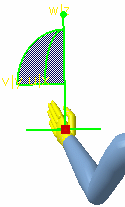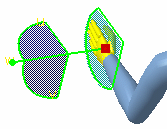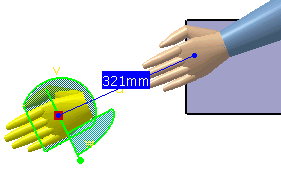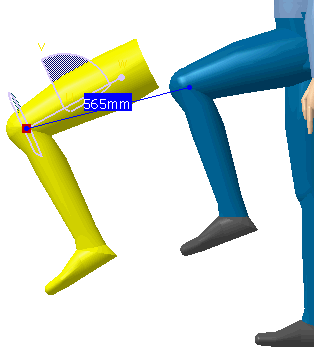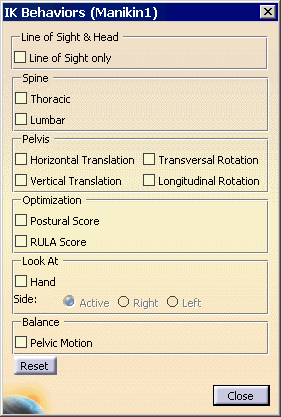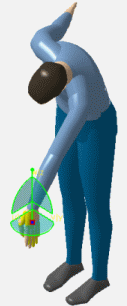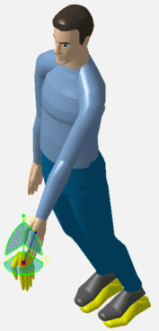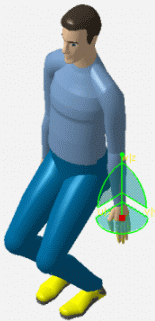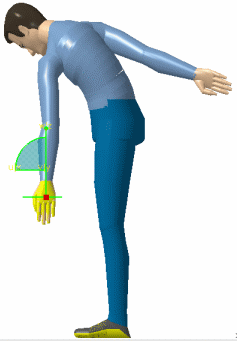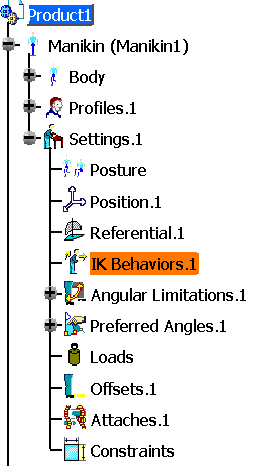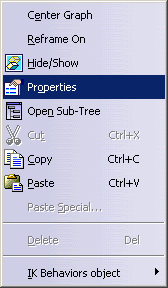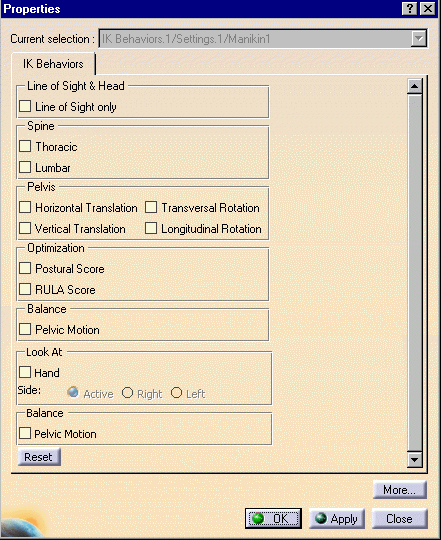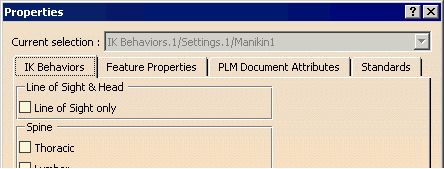|
|
The Inverse Kinematics (IK) mode gives you the
capability to manipulate the manikin's Inverse Kinematics with designed behaviors. This
function is principally for moving the upper body in relationship to the
manipulation of the arms and legs.
This manipulation will eventually induce spine and/or hip motion in order to translate and orient the manikin toward the target. In other words, these behaviors will modify the Inverse Kinematics chain, making it local (limbs only) or global (limbs and spine and pelvis). |
| Two commands are available in Inverse Kinematics mode and either may be
used depending on the need or the operation to be performed (making a new
posture or fine-tuning an existing posture). Both commands provide easy
access to manikin Inverse Kinematics capabilities. The only difference between the two is
in the compass orientation (as illustrated below). These commands are
mutually exclusive; activating one automatically deactivates the other.
For more information, see
Using the Inverse Kinematics Modes.
This example uses the Inverse Kinematics Worker Frame Mode and covers the following
topics: |
|
Inverse Kinematics Worker Frame Mode Command |
|
|
|
From the samples directory, open the Manikin_on_Floor.CATProduct file. |
|
|
|
|
Note that all the options are not mutually exclusive; more than one item can be activated at the same time. For example, activating both the Thoracic and Lumbar options will initiate motion of the entire spine if the target cannot be reached by extending the arms. If multiple Pelvis options are selected, the manikin's pelvis will move (translate, rotate, or laterally orient, depending on the option selected) with or without preliminary spine motion, depending on the selection status of the Spine option. |
|
Segment TwinsThis functionality is available only for the Inverse Kinematics and Position Orientation Reach commands. When the compass is snapped on a hand or foot in Inverse Kinematics and Reach Mode, an image of the entire hand or foot in its current posture will follow the compass. The image will stay there until the Inverse Kinematics or Reach mode is exited.
Setting the Twin optionsFrom the main menu, select Tools > Options > Ergonomics Design & Analysis > Human Builder > Display. In the Twin field choose the desired color and transparency level. |
|
Accessing Inverse Kinematics Behaviors optionsInverse Kinematics Behaviors options can be accessed through the Inverse Kinematics Behaviors command or by right-clicking the Inverse Kinematics Behaviors mode in the PPR tree. Using the Inverse Kinematics Behaviors Command |
|
|
|
Using the Line of Sight & Head optionsWhen selected, the Manikin's vision's line of sight will be directed at what the manikin's hands are reaching. In other words, its like the line of sight will follow the movement of the compass in the Reach or Inverse Kinematics mod when involving the hands. The head will stay stationary. Deactivating this function, and setting the tools > options, the head will also follow the line of sight. This option will be enabled in the Tools > Options menu. See The Manikin eyes follow the 3D compass with Reach and Inverse Kinematics Mode |
|
Using the Spine options |
|
|
|
|
|
Using the Optimization options |
In this IK Behavior panel, the
Optimize
Criteria allows you to choose to optimize the posture
according to either Postural Score or RULA Analysis. This will be in effect when
Inverse Kinematics mode or Reach mode is used, as well as when
the Inverse Kinematics solver is called to resolve a constraints update. When the
Postural Score is activated, then the Inverse Kinematics will always internally refer
to the Postural Score and try to find the best score for each segment
involved in the Inverse Kinematics chain being manipulated. This would have required
you to apply preferred angles to these segments, before using the
optimize capability. If no Preferred Angles are applied to the
manikin, then the Postural Score option would be grayed and made
unavailable. |
|
Using the Pelvis options |
|
|
|
Horizontal Translation |
|
|
|
Vertical Translation |
|
|
|
Transversal Rotation |
|
|
|
Longitudinal Rotation |
|
|
|
Using the Balance optionsThis option enables you to manipulate the manikin with inverse kinematics while keeping the manikin in balance. When these options are selected (only one may be chosen at a time), the balance is checked, in real-time, every time the posture of the manikin changes. |
|
Pelvis Motion |
|
|
|
Accessing Inverse Kinematics Behaviors Properties |
|
|
